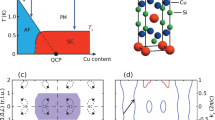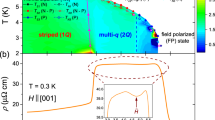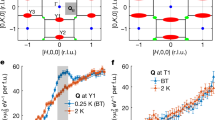Abstract
The origin of unconventional superconductivity, including high-temperature and heavy-fermion superconductivity, is still a matter of controversy. Spin excitations instead of phonons are thought to be responsible for the formation of Cooper pairs. Using inelastic neutron scattering, we present the first in-depth study of the magnetic excitation spectrum in momentum and energy space in the superconducting and the normal states of CeCu2Si2. A clear spin excitation gap is observed in the superconducting state. We determine a lowering of the magnetic exchange energy in the superconducting state, in an amount considerably larger than the superconducting condensation energy. Our findings identify the antiferromagnetic excitations as the main driving force for superconducting pairing in this prototypical heavy-fermion compound located near an antiferromagnetic quantum critical point.
This is a preview of subscription content, access via your institution
Access options
Subscribe to this journal
Receive 12 print issues and online access
$259.00 per year
only $21.58 per issue
Buy this article
- Purchase on SpringerLink
- Instant access to full article PDF
Prices may be subject to local taxes which are calculated during checkout





Similar content being viewed by others
References
Steglich, F. et al. Superconductivity in the presence of strong Pauli paramagnetism: CeCu2Si2 . Phys. Rev. Lett. 43, 1892–1896 (1979).
Miyake, K., Schmitt-Rink, S. & Varma, C. M. Spin-fluctuation-mediated even-parity pairing in heavy-fermion superconductors. Phys. Rev. B 34, 6554–6556 (1986).
Scalapino, D. J., Loh, E. & Hirsch, J. E. d-wave pairing near a spin-density-wave instability. Phys. Rev. B 34, 8190–8192 (1986).
Monthoux, P., Pines, D. & Lonzarich, G. G. Superconductivity without phonons. Nature 450, 1177–1183 (2007).
Mathur, N. D. et al. Magnetically mediated superconductivity in heavy fermion compounds. Nature 394, 39–43 (1998).
Gegenwart, P., Si, Q. & Steglich, F. Quantum criticality in heavy-fermion metals. Nature Phys. 4, 186–197 (2008).
Steglich, F. et al. More is Different—Fifty Years of Condensed Matter Physics 191–210 (Princeton Univ. Press, 2001).
Gegenwart, P. et al. Breakup of heavy fermions on the brink of ‘Phase A’ in CeCu2Si2 . Phys. Rev. Lett. 81, 1501–1504 (1998).
Yuan, H. Q. et al. Observation of two distinct superconducting phases in CeCu2Si2 . Science 302, 2104–2107 (2003).
Rosch, A. Interplay of disorder and spin fluctuations in the resistivity near a quantum critical point. Phys. Rev. Lett. 82, 4280–4283 (1999).
Stockert, O. et al. Nature of the A phase in CeCu2Si2 . Phys. Rev. Lett. 92, 136401 (2004).
Holmes, A. T., Jaccard, D. & Miyake, K. Signatures of valence fluctuations in CeCu2Si2 under high pressure. Phys. Rev. B 69, 024508 (2004).
Steglich, F. et al. New observations concerning magnetism and superconductivity in heavy-fermion metals. Physica B 223–224, 1–8 (1996).
Stockert, O. et al. Magnetism and superconductivity in the heavy-fermion compound CeCu2Si2 studied by neutron scattering. Physica B 403, 973–976 (2008).
Rauchschwalbe, U. et al. Critical fields of the ‘heavy-fermion’ superconductor CeCu2Si2 . Phys. Rev. Lett. 49, 1448–1451 (1982).
Ohkawa, F. Cooper pairs of d x 2 − y 2 -symmetry in simple square lattices. J. Phys. Soc. Jpn 56, 2267–2270 (1987).
Ishida, K. et al. Evolution from magnetism to unconventional superconductivity in a series of CexCu2Si2 compounds probed by Cu NQR. Phys. Rev. Lett. 82, 5353–5356 (1999).
Fujiwara, K. et al. High pressure NQR measurement in CeCu2Si2 up to sudden disappearance of superconductivity. J. Phys. Soc. Jpn 77, 123711 (2008).
Stockert, O. et al. Peculiarities of the antiferromagnetism in CeCu2Si2 . J. Phys.: Conf. Ser. 51, 211–218 (2006).
Scalapino, D. J. & White, S. R. Superconducting condensation energy and an antiferromagnetic exchange-based pairing mechanism. Phys. Rev. B 58, 8222–8224 (1998).
Leggett, A. Where is the energy saved in cuprate superconductivity? J. Phys. Chem. Solids 59, 1729–1732 (1998).
Demler, E. & Zhang, S-C. Quantitative test of a microscopic mechanism of high-temperature superconductivity. Nature 396, 733–735 (1998).
Woo, H. et al. Magnetic energy change available to superconducting condensation in optimally doped YBa2Cu3O6.95 . Nature Phys. 2, 600–604 (2006).
Dahm, T. et al. Strength of the spin-fluctuation-mediated pairing interaction in a high-temperature superconductor. Nature Phys. 5, 217–221 (2009).
Stock, C., Broholm, C., Hudis, J., Kang, H. J. & Petrovic, C. Spin resonance in the d-wave superconductor CeCoIn5 . Phys. Rev. Lett. 100, 087001 (2008).
Haslinger, R. & Chubukov, A. V. Condensation energy in strongly coupled superconductors. Phys. Rev. B 68, 214508 (2003).
Sidis, Y. et al. Magnetic resonant excitations in high-Tc superconductors. Phys. Status Solidi B 241, 1204–1210 (2004).
Christianson, A. D. et al. Unconventional superconductivity in Ba0.6K0.4Fe2As2 from inelastic neutron scattering. Nature 456, 930–932 (2008).
Inosov, D. S. et al. Normal-state spin dynamics and temperature-dependent spin-resonance energy in optimally doped BaFe1.85Co0.15As2 . Nature Phys. 6, 178–181 (2010).
Qiu, Y. et al. Spin gap and resonance at the nesting wave vector in superconducting FeSe0.4Te0.6 . Phys. Rev. Lett. 103, 067008 (2009).
Lumsden, M. D. et al. Evolution of spin excitations into the superconducting state in FeTe1−xSex . Nature Phys. 6, 182–186 (2010).
Bernhoeft, N. et al. Enhancement of magnetic fluctuations on passing below Tc in the heavy fermion superconductor UPd2Al3 . Phys. Rev. Lett. 81, 4244–4247 (1998).
Sato, N. K. et al. Strong coupling between local moments and superconducting ‘heavy’ electrons in UPd2Al3 . Nature 410, 340–343 (2001).
Link, P., Jaccard, D., Geibel, C., Wassilew, C. & Steglich, F. The heavy-fermion superconductor UPd2Al3 at very high pressure. J. Phys. Condens. Matter 7, 373–378 (1995).
Bernhoeft, N. et al. Magnetic fluctuations above and below Tc in the heavy fermion superconductor UPd2Al3 . Physica B 259–261, 614–620 (1999).
Hiess, A. et al. Magnetization dynamics in the normal and superconducting phases of UPd2Al3: I. Surveys in reciprocal space using neutron inelastic scattering. J. Phys. Condens. Matter 18, R437–R451 (2006).
Pailhès, S. et al. Resonant magnetic excitations at high energy in superconducting YBa2Cu3O6.85 . Phys. Rev. Lett. 93, 167001 (2004).
Hayden, S. M., Mook, H. A., Dai, P., Perring, T. G. & Dogan, F. The structure of the high-energy spin excitations in a high-transition-temperature superconductor. Nature 429, 531–534 (2004).
Tranquada, J. M. et al. Quantum magnetic excitations from stripes in copper oxide superconductors. Nature 429, 534–538 (2004).
Eremin, I., Zwicknagl, G., Thalmeier, P. & Fulde, P. Feedback spin resonance in superconducting CeCu2Si2 and CeCoIn5 . Phys. Rev. Lett. 101, 187001 (2008).
Chu, J-H., Analytis, J. G., Kucharczyk, C. & Fisher, I. R. Determination of the phase diagram of the electron-doped superconductor Ba(Fe1−xCox)2As2 . Phys. Rev. B 79, 014506 (2009).
Wiebe, C. R. et al. Gapped itinerant spin excitations account for missing entropy in the hidden-order state of URu2Si2 . Nature Phys. 3, 96–99 (2007).
Acknowledgements
We greatly acknowledge helpful discussions with A. Chubukov, P. Coleman, T. Dahm, I. Eremin, B. Fåk, A. Hiess, D. Scalapino and P. Thalmeier. This work was supported by the Deutsche Forschungsgemeinschaft through Forschergruppe 960 ‘Quantum phase transitions’, as well as by the NSF Grant No. DMR-1006985 and the Robert A. Welch Foundation Grant No. C-1411.
Author information
Authors and Affiliations
Contributions
H.S.J. and C.G. synthesised the sample. O.S., J.A., E.F., M.L., K.S. and W.S. carried out the measurements. O.S., J.A. and S.K. analysed the data. S.K. and Q.S. carried out theoretical calculations. O.S., S.K., Q.S. and F.S. wrote the manuscript. O.S., S.K., Q.S. and F.S. planned and managed the project.
Corresponding author
Ethics declarations
Competing interests
The authors declare no competing financial interests.
Supplementary information
Supplementary Information
Supplementary Information (PDF 449 kb)
Rights and permissions
About this article
Cite this article
Stockert, O., Arndt, J., Faulhaber, E. et al. Magnetically driven superconductivity in CeCu2Si2. Nature Phys 7, 119–124 (2011). https://doi.org/10.1038/nphys1852
Received:
Accepted:
Published:
Issue date:
DOI: https://doi.org/10.1038/nphys1852
This article is cited by
-
A microscopic Kondo lattice model for the heavy fermion antiferromagnet CeIn3
Nature Communications (2023)
-
Unstable antiferromagnetism and large reversible magnetocaloric effect in TmNi2Si2
Science China Materials (2023)
-
Structural and Cryogenic Magnetic Properties of the Ternary RECu2Ge2 (RE = Pr and Nd) Compounds
Journal of Electronic Materials (2022)
-
Magnetic properties and promising magnetocaloric performances in the antiferromagnetic GdFe2Si2 compound
Science China Materials (2022)
-
Isotope effect in heavy fermion superconductor: CeCu2Si2
Proceedings of the Indian National Science Academy (2022)



